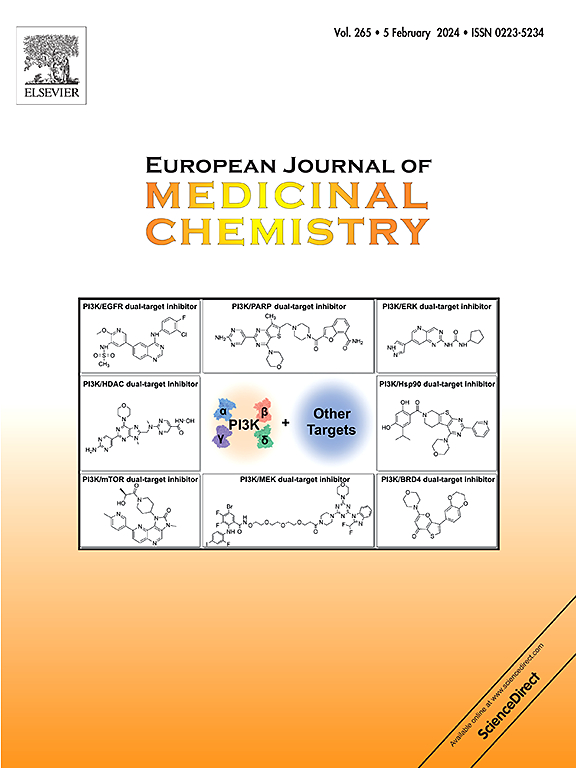Design, synthesis and evaluation of anti-heart failure activity of O-glucoside derivatives
IF 5.9
2区 医学
Q1 CHEMISTRY, MEDICINAL
引用次数: 0
Abstract
Heart failure (HF) is a progressive disease characterized by persistent or episodic worsening of symptoms, leading to functional deterioration. Clinically, guidelines recommend the use of SGLT2 inhibitors for the treatment of heart failure. However, the SGLT2 inhibitors exist potential risks including weight loss and euglycemic diabetic ketoacidosis. We designed and synthesized a series of O-glucoside derivatives by introducing nitrogen-containing heterocyclic fragments. Among them, compound E9 showed the most protective effect on the glucose-free DMEM-induced injured cardiomyocytes, and the structure-activity relationships (SAR) of these compounds were preliminarily evaluated in cardiomyocyte injury model. Furthermore, compound E9 significantly enhanced the inhibition of SGLT2, NHE1, and SOD enzyme activity, increased ATP levels in damaged cardiomyocytes, and suppressed Ang II-induced myocardial fibrosis, the autophagy receptor protein P62 and the expression of cell injury markers. Additionally, compound E9 significantly improved cardiac function in TAC-induced HF mice, inhibited cardiomyocyte hypertrophy and collagen deposition, ameliorated myocardial tissue damage, enhanced mitochondrial autophagy in injured cardiomyocytes, and ultimately increased survival rates in HF mice. In conclusion, this study reveals that the novel O-glucoside derivative E9 was a promising compound for the treatment of heart failure.


o -葡萄糖苷衍生物抗心力衰竭活性的设计、合成及评价
心力衰竭(HF)是一种进行性疾病,其特征是症状持续或发作性恶化,导致功能恶化。临床上,指南推荐使用SGLT2抑制剂治疗心力衰竭。然而,SGLT2抑制剂存在潜在的风险,包括体重减轻和糖尿病酮症酸中毒。我们通过引入含氮杂环片段,设计合成了一系列的o -葡萄糖苷衍生物。其中化合物E9对无糖dmem诱导的心肌细胞损伤的保护作用最强,并在心肌细胞损伤模型中初步评价了这些化合物的构效关系(SAR)。此外,化合物E9显著增强了对SGLT2、NHE1和SOD酶活性的抑制,增加了受损心肌细胞ATP水平,抑制了Ang ii诱导的心肌纤维化、自噬受体蛋白P62和细胞损伤标志物的表达。此外,化合物E9显著改善tac诱导的HF小鼠心功能,抑制心肌细胞肥大和胶原沉积,改善心肌组织损伤,增强损伤心肌细胞线粒体自噬,最终提高HF小鼠存活率。综上所述,本研究揭示了新型o -葡萄糖苷衍生物E9是一种治疗心力衰竭的有前景的化合物。
本文章由计算机程序翻译,如有差异,请以英文原文为准。
求助全文
约1分钟内获得全文
求助全文
来源期刊
CiteScore
11.70
自引率
9.00%
发文量
863
审稿时长
29 days
期刊介绍:
The European Journal of Medicinal Chemistry is a global journal that publishes studies on all aspects of medicinal chemistry. It provides a medium for publication of original papers and also welcomes critical review papers.
A typical paper would report on the organic synthesis, characterization and pharmacological evaluation of compounds. Other topics of interest are drug design, QSAR, molecular modeling, drug-receptor interactions, molecular aspects of drug metabolism, prodrug synthesis and drug targeting. The journal expects manuscripts to present the rational for a study, provide insight into the design of compounds or understanding of mechanism, or clarify the targets.

 求助内容:
求助内容: 应助结果提醒方式:
应助结果提醒方式:


